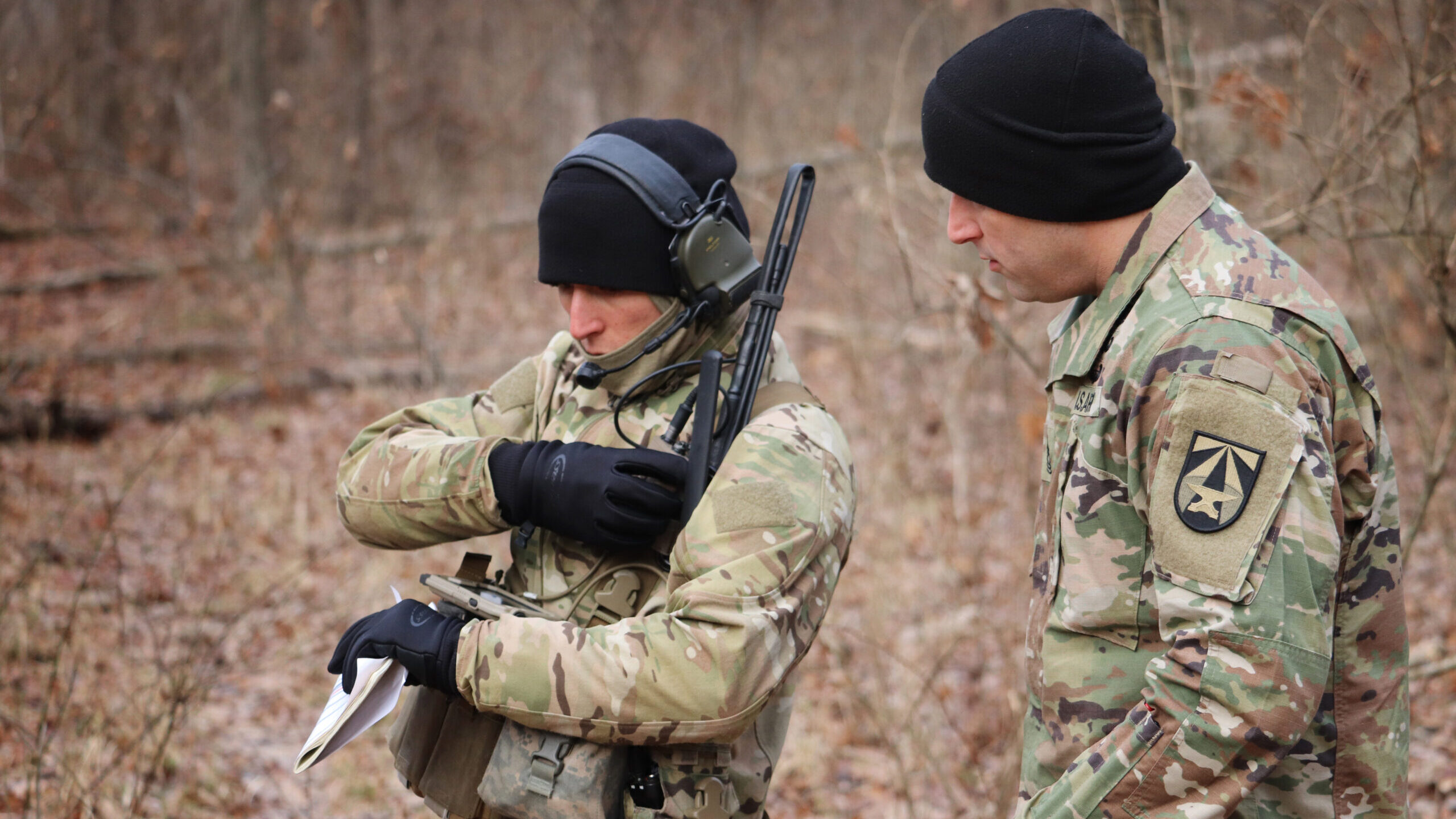
A forward observer with the 508th Parachute Infantry Regiment, 82nd Airborne Division uses Integrated Tactical Network components during a live-fire exercise at Camp Atterbury, Indiana, in January 2019. (U.S. Army photo by Kathryn Bailey, PM Tactical Radios, PEO C3T Public Affairs)
PHILADELPHIA: The Russian invasion of Ukraine has underscored the importance of communications, logistics and “baked-in” cybersecurity, reinforcing the concepts the Army is pushing forward with its network capability set development, according to service officials.
Speaking to reporters at the sidelines of an Army Technical Exchange Meeting, Maj. Gen. Rob Collins, the service’s program executive officer for command, control, communications-tactical (PEO C3T) said Tuesday the invasion has brought the Army “back to the basic blocking and tackling of transmission security [and] communications security.”
“And also when you have a living and breathing threat, you need to think about the things such as a contested and congested environment,” Collins said. “And that’s just not something in the small scale… It is reinforcing some of the concepts that we’re pushing forward within the capability set strategy.”
The Army is developing and fielding capability sets — tool kits of applications and technology designed to modernize network capabilities across the service — every two years. The first set, Capability Set 21, is about 70% fielded, and units deployed in Europe to support NATO are currently using elements of the set.
CS21 is focused on making the network more intuitive and includes single-channel commercial radios with advanced networking waveforms, small aperture satellite terminals, high-capacity line-of-sight radios among other components, all designed to enable resilient communication.
The next step is conducting a two-phased operational assessment with CS23, both with the 2nd Cavalry Regiment in Europe beginning in June to get real time operational feedback to help the Army decide what to field
The service will also begin experimenting with US Army Pacific for cloud, data and mission command applications starting later this summer and fall. At the same time, the service is also working on developing capability sets 25 and 27.
Russian troops have reportedly run into critical communications issues so far in their ill-fated invasion of Ukraine, at times relying on unencrypted radios or even Ukrainian cell phone service to coordinate operations.
RELATED: CYBERCOM increasing intel collection in light of Russia-Ukraine conflict
Collins also highlighted, like Army officials before him, the importance of logistics in the Ukraine conflict. In the early days of the invasion, Russia struggled to keep a logistics line to its front line forces, leading soldiers to ditch vehicles that were broken or out of gas on the side of the road.
Collins didn’t get into details on the logistics side, but meanwhile on Capitol Hill Tuesday, another Army officer was making a similar point.
Lt. Gen. James Richardson of Army Futures Command told the Senate Armed Services Committee that three major takeaways for him were all logistics-related: the need for reliable weapons and systems, the ability to have predictive logistics to know beforehand when something’s about to fail or run out, and the importance of a common “operational picture” from the battalion level to the front lines so logistical operations can be executed efficiently.
Collins’ and Richardson’s remarks follow comments made by Under Secretary for Research and Engineering Heidi Shyu in March.
“Looking at the logistics problems the Russians are having. It’s a contested logistics environment. It’s not even that contested – it could be a lot more contested, a lot more difficult,” Shyu said then. “So we truly want to focus on that area.”
Shyu is focusing in part on contested logistics through the Defense Department’s Rapid Defense Experimentation Reserve, an effort aimed at addressing capability gaps and emerging technologies. The Pentagon is in the planning stages of the second “sprint” of RDER, she said.
At the Army Technical Exchange Meeting, Brig. Gen. Jeth Rey, director of the service’s network cross-functional team, said the Ukraine war also has shown the service the importance of baking in cybersecurity into systems.
“That’s what we’re learning from this — we’re going to be so distributed in the fight and we’ve seen how they’re distributed… those mission command systems have [to have] built in cybersecurity,” he said. “It has to be baked in up front because that’s where we’re doing a lot of lessons learned on the systems that they currently have on the ground.”
Officials from the Pentagon’s information security agency in April also emphasized the need to “bake in” resilient information-sharing in light of the Ukraine conflict.
Caroline Bean, acting director for the Defense Information Systems Agency’s joint enterprise services directorate, said the agency is starting to think of challenges from the beginning, like denied and disconnected low bandwidth situations, instead of that being an afterthought as it aims to deliver enterprise services with the “foundation” of the military’s joint All Domain Command and Control initiative.
“We’re thinking of it from the beginning because we need to do things differently… The situation in Ukraine has made this more evident that we need to do the information sharing and we need to… mobilize our enterprise services,” she said.






















